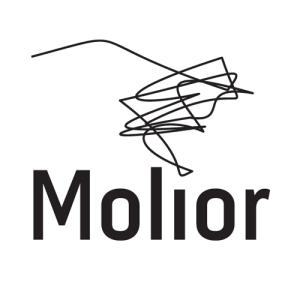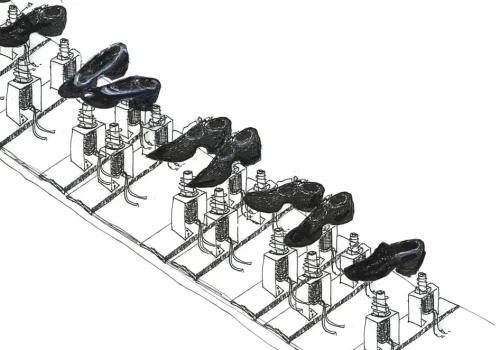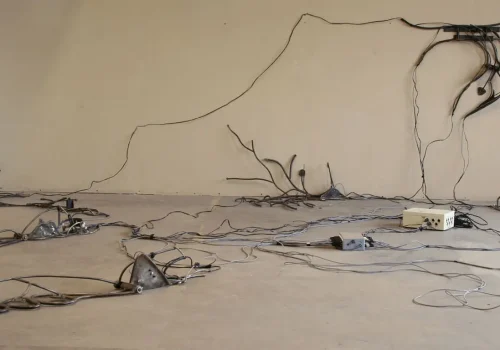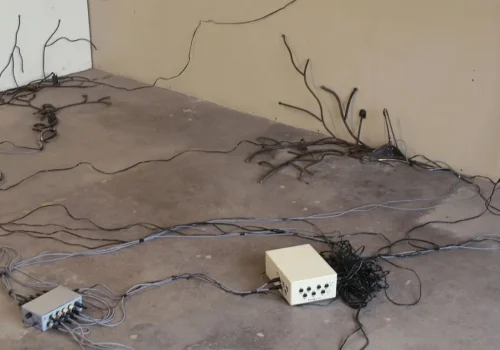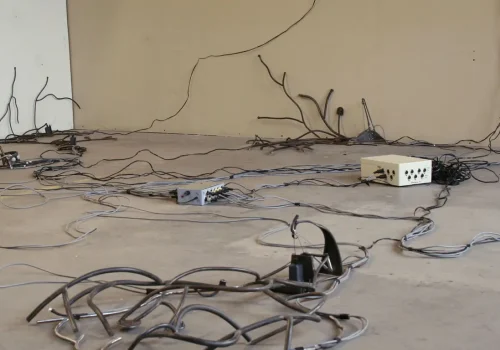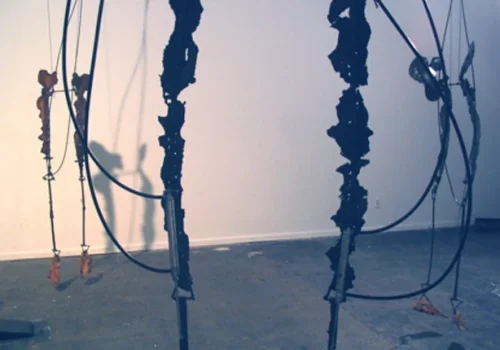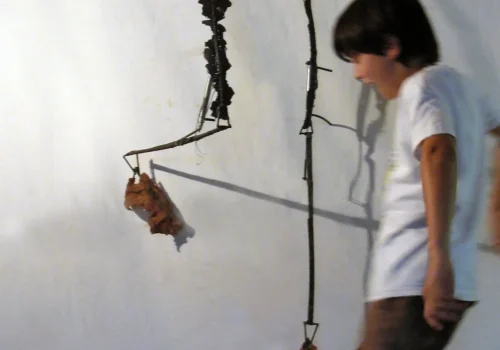B/R/T The Inhabited Body
3520 rue St-Jacques, Montréal
From November 1st to December 2nd, 2007
B/R/T The Inhabited Body – Ingrid Bachmann, Natacha Roussel, and Jane Tingley use automata to create a viewing experience both physical and emotive. What is striking about their works is the way they use technology to address issues related to the body: the body as a sensitive environment (Tingley), the object as the body’s memory (Bachmann), and the body as movement experienced (Roussel).
B/R/T Le corps habité – The Inhabited Body / Jason Arsenault
Ingrid Bachmann, Natacha Roussel, and Jane Tingley use automata to create a viewing experience both physical and emotive. What is striking about their works is the way they use technology to address issues related to the body: the body as a sensitive environment (Tingley), the object as the body’s memory (Bachmann), and the body as movement experienced (Roussel).
These artists’ observations give rise to the various hypotheses underlying their work. They create spaces of enquiry using new media, through which they convey the complexity of the body’s experience. Here, technology is transformed from its everyday uses into works of art without idealizing its function or exploiting it in a technical demonstration. Bachmann, Roussel, and Tingley accentuate its imperfections, weaknesses, and shortcomings — akin to those of the human body. Their work suggests a body laid bare as machinery, which takes shape through the installation, objects, or the immersive environment.
In their use of electronic and mechanical systems, these three artists propose a re-examination or recognition of the body through the machine. Be it by taking the observer on a journey through the central nervous system by simulating different layers of the epidermis (Tingley), creating a tap-dance symphony for absent bodies using 27 pairs of shoes (Bachmann), or encouraging us to re-examine how we walk by means of a prosthesis in the form of mechanical legs (Roussel), the three artists demonstrate various alternative means of inhabiting the body than is possible in our everyday lives.
These robotic works invite us to immerse ourselves within their sound environments and confront our experience as viewers with the sounds of machinery. Mechanical and metallic sounds pierce the air and hypnotize us with their rhythms (Bachmann) or surprise us with their industrial qualities (Tingley and Roussel). Overall, the sound in these works has the effect of creating a sense of uncertainty on the part of those observing or listening. It is as though these machines were examining, spying or seeking, through our mere presence, to mimic our behavior. The effect of these sound environments is to continuously stimulate our attention and put us in a constant state of alert.
Today, the physical body tends to be regarded as something imperfect — too much of this, not enough of that — as if something could always be improved, corrected, or refurbished. The organic body, and by extension that of the viewer, is forced to confront the mechanical body found in these works. The machine has an aura which shapes our present-day conception of the world. It seeks, in our modern mythology, to be without fault, offering the capacity to be regulated, adjusted, and replaced as required if it is unable to perform its duties adequately. The machine amplifies the myth of perfection. With the scope of medical and technological progress today, the body is increasingly called upon to function according to these rules. We should note that these artists are not interested in rendering these body-machines perfect by glorifying them, but rather by making them slightly dysfunctional, although complete and well-made as objects and works of art, to highlight these relations between the body and the machine.
Together, these works share a desire to experience and explore technology, not in a cold and purely technical manner but rather as an experience of the unknown related to the body. They are technological works, inspired by living structures, which seek to confront and relate the organic body to the machine-body, thereby calling into question the role and functions of each.
Jason Arsenault
Andrée Duchaine
Andrée Duchaine has worked in the visual arts area since several years. From 1974 to 1984 she was involved in setting up the video section at Vehicule Art Gallery and organized and curated VIDEO 84, the first international video encounters in Montreal. Mrs Duchaine curated several video art exhibitions in Europe, the United States and Canada. Between 1985 and 1995 she settled in Paris where she founded a short film distribution company. She worked with T.V. channels across the world.
Andrée Duchaine taught at Paris VIII, at the Université du Québec à Montréal and at the Ottawa University. In 2001 she founded a non-profit company Le Groupe Molior producing, curating and disseminating new media works.
Jason Arsenault
Jason Arsenault has a master’s degree in film studies and works in the fields of visual and media arts as an artist and independent curator. He is particularly interested in work which redefines the viewer’s experience. He currently chairs the board of directors of the organization Perte de Signal.
Artists & works
Ingrid Bachmann
Symphony for 54 Shoes (Distant Echoes)
2007
Installation
Description of the work
By incorporating everyday objects into her work, Bachmann interrogates the sublime often associated with technology. Symphony 54 Shoes (Distant Echoes) explores the pathos of technology by staging an unproductive act. Set out on six shelves, 27 pairs of shoes move and dance independently of each other.
In this kinetic work, the movement of the shoes in a sense attempts to highlight the absence of the people who wore them. This is why the work is not interactive. On the bottom of each shoe, Bachmann has attached a tap-dance toe plate, thereby creating an antispectacular spectacle in which the emphasis is placed on the creation of a sound ambience, programmed to give the impression that it is a product of chance. These sounds bring the exhibition space to life, providing viewers with a constant aural presence. The experience anchors the viewers firmly in the present, and leaves them seeking the sound sources which activate the various shoes while letting themselves be drawn into the rhythm created by the work.
Technical Assistance: Chris Flower
Circuit Design and Programming: Erik Conrad
Financial Support: FQRSC (Fonds québécois de la recherche sur la société et la culture)
Biography
Lives and works in Montreal
Ingrid Bachmann is known for her interactive installations that combine technology and everyday objects. Her multidisciplinary works draw on the textile, sculpture and kinetic art fields. Her use of technology seeks to demystify it and make it more human, by integrating a sensual and emotional dimension that counters the alienation that is often associated with the machine.
Her work has been exhibited in Quebec, Canada and abroad, notably in Europe on several occasions. She has also taken part in many international visual and digital arts events. Molior presented her work as part of Despertar / Éveil / Alive at Sesc Santana in Sao Paulo (Brazil) in 2014, Transitions / Transiciones, at Centro Cultural de la Pontificia Universidad Católica del Perú, Lima (Peru) and during B/R/T Le corps habité in Montreal, 2007.
An associate professor at Concordia University (Montreal), Ingrid Bachmann was a founding member of Hexagram, an interuniversity media arts research and creation centre. She is the director of the Institute of Everyday Life, a studio laboratory that examines everydayness. She has been a guest speaker at Goldsmiths College (London, UK), the University of Wollongong (Australia), the University of Maryland (Baltimore) and the Art Institute de Chicago.
Jane Tingley
Peripheral Response
2005-2009
Interactive Installation
Description of the work
Cutaneous Sensation. The sensitivity of the skin, with its sensorial receptors, enables us to transform outside information into nervous impulses, which then travel through the central nervous system to be interpreted. With Peripheral Response, Tingley has created an interactive environment inspired by this process. She links and robotizes modules which hammer the wall and floor in response to the presence of visitors.
The mere action of standing in front of one of the nine elements which make up this immersive environment sets off a series of actions in each of them. This journey to the heart of the body brings us into contact with various layers of the epidermis, thereby situating viewers at the heart of the representation. Without their presence, these elements would stop moving due to lack of stimuli.
Peripheral Response is a depiction of the microscopic chain reaction of the various parts of the human epidermis. The result is an impressive spider’s web, like a network of sensitive components which make possible an interaction with the viewers, who are connected to a simulated central nervous system, a computer-brain controlling various sensors.
For his Technical Assistance, Special Thanks to: Martin Peach
Financial Support: Manitoba Arts Council, Rossetti Montréal, le Centre interuniversitaire des arts médiatiques (CIAM) , P.E.O. (Philanthropic Educational Organization)
Biography
Jane Tingley, who received her MFA from Concordia University in 2006, uses new media, sculpture, and installation to explore ideas involving identity and contemporary experience. She is one of the founding members of the Modern Nomads and has participated in exhibitions and festivals in Canada, Asia, and Europe, including Translife – International Triennial of Media Art at the National Art museum of China in Beijing, the Canadian Embassy and Gallerie Le Deco in Tokyo, Japan, Festival Break 2.3 in Ljubljana, Slovenia, Elektra Festival in Montreal, and the Künstlerhaus in Vienna, Austria. She was awarded the Kenneth Finkelstein Prize in sculpture, and has received support from a number of funding agencies, including the Manitoba Arts Council, Conseil des arts et des lettres du Québec, and the Canada Council for the Arts.
Natacha Roussel
Take Off Your Legs
2000
Installation interactive
Description of the work
Walking involves putting one foot in front of the other, trampling the ground underfoot. In a more figurative sense, to walk is to move towards some goal or objective. In Take off your Legs, Roussel examines the theme of walking through our experience of the other’s body by means of movement, which in this case goes nowhere because it is only movement. Using an interactive system, she only movement. Using an interactive system, she only employs mechanical legs suspended in the air which are brought to life through the participation of the viewers, so that they may relate their own movements to those produced by the machine.
The first public exhibition of Take off your Legs was in the form of a performance in which a dancer interacted with the work. The piece was later modified to become an installation. Roussel invites us to activate and interact with this prosthesis by walking on a module containing a mechanical interface placed next to the work. Viewers position themselves in such a way as to make the work move, function, and take on life. Through this interface, Roussel positions viewers in the present as a central component of the action, thereby succeeding in making us aware of our own verticality, our own way of walking.
Biography
Natacha Roussel creates physical interfaces with poetic, surrealist, and sensorial qualities which closely involve the participant. Her interactive installations range from prostheses to interactive clothing. These interfaces have taken the form of manipulable sculptural objects and, more recently, clothing. Her work has received the support of the Canada Council for the Arts (2004, 2006) and the Conseil des arts et des lettres du Québec (2001) for the creation of installations while in artistic residence. While carrying out a master’s degree in interactive design (2004), under the supervision of Joanna Berzowska, she became interested in designing interactive clothing, her current focus of interest.
In 2003, she founded the collective Experientiae Electricae with a graphic designer, an electronics expert, and a programmer. Driven by the desire to go beyond their respective media, they use the potential made possible by their collaboration to incorporate technologies based on rudimentary electrical operations to create multimedia works.
